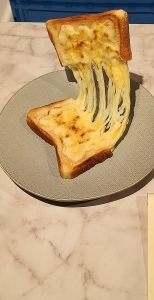See it, savour it, but do not put it in your mouth
IF YOU HAVE NEVER heard of ‘shokuhin sanpuru’, you are not alone. It was only after visiting an exhibition called “Looks Delicious” at Japan House in London’s High Street Kensington on its penultimate day (15 February 2025) that I realised that I had often seen examples of shokuhin sanpuru (replicas of food) without realising what they are called in Japanese.
 Replica of toast with melted cheese
Replica of toast with melted cheeseJapanese restaurants and eateries display lifelike replicas of the food they offer to customers. They are designed both to show the customer both what to expect and to entice him or her to enter the establishment to order and then eat their kitchen’s fare. The replicas are ‘hyper-realistic’. These mouthwatering looking models are both informative and of a commercial nature: they are designed not only to depict the dishes but also to evoke in the viewer’s mind the desire to consume them. According to the exhibition catalogue (see: https://www.japanhouselondon.uk/whats-on/looks-delicious-exploring-japans-food-replica-culture/) the origin of these replicas:
“… can be traced back to the early 20th century. As ‘Western’ cuisine grew in popularity in Japan, restaurateurs needed a way to visually communicate their menus to a curious yet cautious public. Food replicas were made entirely out of wax until the 1970s, when the introduction of synthetic resin transformed their production, allowing for greater detail, durability and more dynamic display.”
The catalogue noted:
“Every effort is made to ensure food replicas appear as realistic as possible. Food replica craftspeople not only reproduce the appearance of food; they also recreate the memory of it in people’s imaginations. For example, while red bean paste may, in reality, not be that grainy, people often associate it with a grainy texture.”
The exhibition at Japan House includes examples of replicas of many kinds of Japanese food as well as of European (‘Western’) dishes. As the catalogue explained, the replicas are not only made to entice customers into eateries, but also for other purposes:
“Beyond their use as a marketing tool, food-replica technology also has wide ranging applications, notably in nutritional education and medical science.”
In addition, replicas can be made to be used as standards by which the appearance of actual food products and ingredients can be assessed.
The show at Japan House includes models and films showing how the replicas are created. Often the real food is coated with a liquid material that is used to make a three-dimensional impression (mould) of the dish. The food is then removed from the newly formed impression, and the detailed impression/mould is then set in a solid base of plaster of Paris. Then, wax or resin is poured into the mould to produce a replica. The replica is then carefully painted to recreate the appearance of the dish or food item. To recreate textural features, such as the delicate marbling on Wagyu beefsteak or fish scales, there are carefully prepared stencils, which can be laid on the models whilst paint is applied through the perforations in them. I have simplified the description of the manufacturing process, but rest assured that the production of these unbelievably realistic replicas can only be done by highly skilled craftsmen.
The unusually fascinating exhibition should not be viewed, as we did, when hungry. The replicas on display can only increase your desire to eat. They looked so enticing that it was difficult not to reach out and pick them up to eat. However, apart from not being allowed to touch them, as realistic as they look, they are completely inedible.



